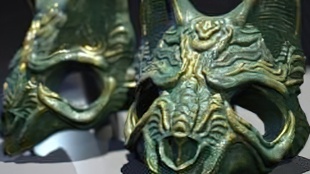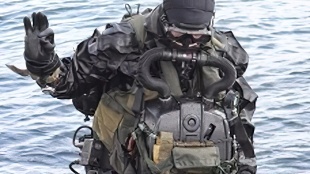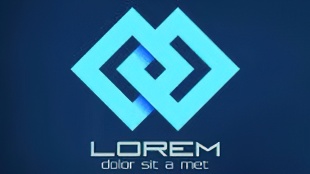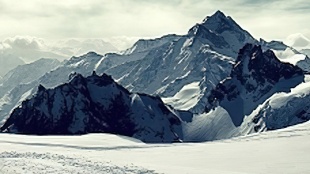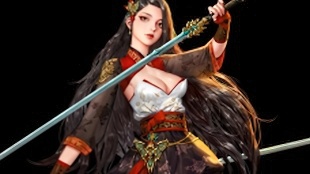您需要 登录 才可以下载或查看,没有账号?注册

x
本帖最后由 七月纪旅。 于 2022-8-10 22:10 编辑

Introduction
I’m Lorenzo Drago, an Italian 3D artist with a university background in Communication Design.
I started as a self-taught Blender artist as a teenager and, for the past three years, I’ve been focusing on Game Art through university classes, freelance work, mod and indie development, as well as personal projects.
介绍
我是Lorenzo Drago,一位意大利3D艺术家,拥有传播设计大学背景。
我十几岁时开始自学成才,在过去的三年里,我一直专注于游戏艺术,通过大学课程,自由职业者工作,mod和独立开发,以及个人项目。
Project and Goals
I’m a relative newcomer to Unreal Engine. Before Etchū-Daimon Station, I used Unreal Engine 4 for the first time in my Mansion project, earlier this year. Before then, I had used Unity for a few years, familiarizing myself with its render pipelines and simple scripting.
项目和目标
我是虚幻引擎的新手。在《Etchū-Daimon Station》之前,我在今年早些时候的Mansion项目中首次使用了虚幻引擎4。在此之前,我已经使用Unity几年了,熟悉了它的渲染管道和简单的脚本。
In May, I released my newest portfolio piece, an environment based on Etchū-Daimon Station in Imizu, Japan, running in Unreal Engine 5.
Since I’ve received quite a few questions about it since I thought it would be useful to go over the process I used to create it.
五月份,我发布了我最新的作品集,这是一个基于日本Imizu的Etchū-Daimon Station的环境,在虚幻引擎5中运行。
由于我收到了很多关于它的问题,因为我认为回顾一下我用来创建它的过程会很有用。

To tell the truth, every other project currently on my Artstation started as a commission or an assignment. This was my first, serious, entirely personal project in some time, so I was free to aim for an aesthetic that resonates with me. I decided to aim for a certain type of photorealism; I wanted the scene to have a nuanced, mundane feeling to it, and I tried to follow that direction in everything, from the choice of subject to the video presentation.
说实话,目前在我的Artstation上,所有其他项目都是作为委托或任务开始的。这是我在一段时间内的第一个,严肃的,完全个人的项目,所以我可以自由地追求一种与我产生共鸣的美学。我决定瞄准某种类型的照片写实主义;我希望这个场景有一种微妙的,平凡的感觉,我试图在一切事情上都遵循这个方向,从主题的选择到视频演示。
This would also allow me to work on my use of references, proportions, and materials, areas that I thought needed improvement from my previous projects. While journeying by local trains across Japan a few years ago, I had the chance to stop at a few of these countryside or middle-of-nowhere train stations, and I find that they have a very unique, nostalgic atmosphere.
这也将允许我使用参考,比例和材料,我认为需要从我以前的项目中改进的领域。几年前,当我乘坐当地火车穿越日本时,我有机会在这些乡村或偏僻的火车站停留,我发现它们有一种非常独特,怀旧的氛围。
While looking for references, I stumbled upon a picture of the real Etchū-Daimon Station and thought it would make for a good subject. I started Etchū-Daimon Station on UE4, and switched to UE5 halfway through.
在寻找参考资料时,我偶然发现了一张真正的Etchū-Daimon站的照片,并认为这将是一个很好的主题。我在UE4上启动了Etchū-Daimon Station,并在中途切换到UE5。
This was also one of the reasons I didn’t end up using Nanite for my assets. At the start of the project I was limited to working on an old PC (using a GTX 980 GPU), and found that UE5 actually performed better in some ways, especially as Lumen cut out the excessive baking times for Lightmass and allowed me to iterate on lighting faster.
这也是我最终没有使用Nanite作为我的资产的原因之一。在项目开始时,我仅限于在一台旧PC上工作(使用GTX 980 GPU),并发现UE5在某些方面实际上表现得更好,特别是当Lumen减少了Lightmass的过多烘焙时间并允许我更快地迭代照明时。
Migrating the project to UE5 was seamless: I only had to enable the new rendering features in the Project Settings and switch all the lighting to real-time.
将项目迁移到UE5是无缝的:我只需要在项目设置中启用新的渲染功能,并将所有光照切换到实时。
Inspiration and References
灵感和参考
My main reference picture, sourced from .
我的主要参考图片,来自https://commons.wikimedia.org/w/index.php?curid=58951496。
Most of my reference images were collected in PureRef. I was lucky to find a lot of photographs of the location across Google Maps and Wikimedia Commons. These images make up the bulk of my references. As I went on, I added more specific reference images for individual objects like windows, overhead structures, electrical boxes, and so on. I also used some smartphone footage of my own as lighting, animation and post-processing reference.
我的大部分参考图像都是在PureRef中收集的。我很幸运地在谷歌地图和维基共享资源中找到了很多关于这个位置的照片。这些图像构成了我的大部分参考资料。随着我的继续,我为单个对象(如窗户,架空结构,电气箱等)添加了更具体的参考图像。我还使用自己的一些智能手机素材作为照明,动画和后期处理的参考。
Blockout and Planning
封锁和规划
I think that believable proportions are essential to realism. I didn’t want to run into the pitfall of making objects too large or bulky, which was a habit I picked up doing more stylized or “gamey” art.
我认为可信的比例对于现实主义至关重要。我不想遇到让物体变得太大或笨重的陷阱,这是我养成的习惯,做更风格化或“游戏化”的艺术。
For this reason, I used camera matching as a basis: I ran my main reference image through fSpy and imported it into Blender to create a simple blockout. I looked up the average height of a step to determine the scale of the scene.
出于这个原因,我使用相机匹配作为基础:我通过fSpy运行了我的主参考图像,并将其导入Blender以创建一个简单的块。我查找了一个步骤的平均高度,以确定场景的比例。
With this, I had some fairly accurate real-world measurements, which I used as a basis to plan how the scene would be separated into modules. I adjusted the measurements to better
fit the grid and allow easier snapping.
有了这个,我有了一些相当准确的现实世界测量,我用它们作为计划如何将场景分成模块的基础。我调整了测量值以更好地
适应网格并允许更容易捕捉。
Having also highlighted other essential objects present in the reference, I was able to come up with a flexible list of what assets I would need to make and how to tackle them, to use as a starting point.
在强调了参考文献中存在的其他基本对象之后,我能够提出一个灵活的列表,列出我需要制作哪些资产以及如何处理它们,以用作起点。
Modeling and Texturing
From there, I was able to start working on individual assets. From the start, I had to keep in mind how the assets would be textured, in order to keep a uniform texel density and reasonable texture sizes. For this reason, the scene is a balance of custom-textured assets and assets that use tileable textures or trim sheets.
建模和纹理
从那里,我能够开始处理单个资产。从一开始,我必须牢记资源的纹理方式,以保持统一的纹理密度和合理的纹理大小。因此,场景是自定义纹理资源和使用可平铺纹理或裁切工作表的资源的平衡。
For example, the steps are custom-textured assets.
I started from a mid-poly model to create both a high-poly mesh with some simple sculpted damage and a low-poly mesh to bake normal maps to Substance 3D Painter. I created a module of three steps.
例如,这些步骤是自定义纹理资源。
我从中多边形模型开始,既创建了具有高多边形网格(具有一些简单的雕刻损伤)和低多边形网格,以将法线贴图烘焙到Substance 3D Painter。我创建了一个包含三个步骤的模块。
To reduce repetition, I also alternately mirror the texture and rely on vertex color blending in the material to control which areas are dirty. For this reason, I created the low-poly version so it would be easy to add edge loops where more vertex detail was necessary.
为了减少重复,我还交替地镜像纹理,并依靠材质中的顶点颜色混合来控制哪些区域是脏的。出于这个原因,我创建了低多边形版本,以便很容易添加需要更多顶点细节的边缘环。
Other objects, like the painted wood planks or the yellow tactile paving, use tiling textures and trim sheets. I created most of these textures from scratch as well.
其他物体,如彩绘木板或黄色触觉铺路,使用平铺纹理和装饰板。我也从头开始创建了大部分这些纹理。
For tileable textures, Substance 3D Designer might be a more popular choice, but since these are fairly hard-surface materials, I found it easier to use the same high-poly to low-poly workflow together with Substance 3D Painter.
对于可平铺纹理,Substance 3D Designer可能是一个更受欢迎的选择,但由于这些是相当坚硬的表面材质,我发现将相同的高聚体到低多边形工作流程与Substance 3D Painter一起使用更容易。
This way, I could generate AO and curvature maps and paint areas by hand to achieve a less procedural look. The only thing I had to keep in mind when making tileable textures in Painter is that every grunge map also needed to use whole numbers for its tiling.
通过这种方式,我可以手动生成AO和曲率贴图并绘制区域,以实现不那么程序化的外观。在 Painter 中制作可平铺纹理时,我唯一需要记住的是,每个垃圾贴图也需要使用整数进行平铺。
When making my high-poly meshes, I made sure to introduce imperfections like subtle rotation, size differences, and warping. These get picked up in the normal map when baking and help create a more organic-looking texture.
在制作高多边形网格时,我确保引入不完美,如细微的旋转、大小差异和翘曲。这些在烘焙时会在法线贴图中拾取,并有助于创建更具有机外观的质地。
Some objects are a combination of custom-textured parts and tileable textures.
某些对象是自定义纹理部分和可平铺纹理的组合。
The painted metal beams that are all over the station are built this way: using a tileable texture for the main body gives me flexibility, plus I can offset or mirror it to minimize repetition; meanwhile, the base, bolted areas and terminal parts are custom-textured, so I can still capture the bevels in the normal map.
遍布车站的彩绘金属梁都是这样建造的:在主体上使用可平铺纹理给了我灵活性,而且我可以偏移或镜像它以尽量减少重复;同时,底座、螺栓连接区域和端子部件是自定义纹理的,因此我仍然可以在法线贴图中捕获斜角。
The only area where I relied on an asset library was foliage: I’m not an experienced foliage artist, so I worried that using my own models would drag the project’s realism down. However, I also knew from my references that grass needed to be in the scene, so, since it’s not the main focus, I decided to use assets sourced from the Megascans library.
我唯一依赖资源库的领域是树叶:我不是一个有经验的树叶艺术家,所以我担心使用自己的模型会拖累项目的真实感。但是,我也从参考资料中知道草需要出现在场景中,因此,由于它不是主要焦点,我决定使用来自Megascans库的资源。
I didn’t have a lot of experience using Megascans before, so I had some trouble getting their foliage to look right. I still have more to learn in this aspect, though I believe the library can be very useful for bringing a scene to the highest level of quality without increasing the workload beyond a single artist’s capabilities. Using it allowed me to focus more on the goals I had initially set for myself.
我以前没有太多使用Megascan的经验,所以我很难让它们的叶子看起来正确。在这方面,我还有更多需要学习的东西,尽管我相信该库对于在不增加超出单个艺术家能力的工作量的情况下将场景提升到最高质量水平非常有用。使用它使我能够更多地关注我最初为自己设定的目标。
Decals and Vertex Blending
贴花和顶点混合
I also created decals like stains, cracks and concrete patches.
我还创建了污渍,裂缝和混凝土补丁等贴花。
Some of these I created from scratch; for others, I started with photographs that I derived grayscale alphas from for use in Substance 3D Painter.
I found that using Anchor Points in Painter was a good way to create layering based on a starting grayscale alpha.
其中一些是我从头开始创建的;对于其他人,我从我从中获取灰度alpha的照片开始,以便在Substance 3D Painter中使用。
我发现在 Painter 中使用 Anchor Points 是基于起始灰度 Alpha 创建分层的好方法。
As I mentioned earlier, I also did some work in Unreal Engine’s Material Editor, mostly to break up repetition using vertex color or alphas. Parallax Occlusion Mapping was essential to give a three-dimensional look to some materials like the gravel under the tracks or the tactile paving while remaining in my self-imposed low-poly constraints.
正如我之前提到的,我还在虚幻引擎的材质编辑器中做了一些工作,主要是使用顶点颜色或alpha来分解重复。视差遮挡映射对于为某些材料(如轨道下的砾石或触觉铺路)提供三维外观至关重要,同时保持在我自我施加的低多边形约束中。
For the night scene, I created wet instances of my materials. In the simplest cases, this meant plugging the roughness map into a RemapValueRange node. For the ground materials, I also added puddles: this is achieved by blending the original material with a puddle material with a mask created by overlaying vertex color, a procedural noise and optionally a heightmap.
对于夜景,我创建了我的材料的湿实例。在最简单的情况下,这意味着将粗糙度映射插入 RemapValueRange 节点。对于地面材质,我还添加了水坑:这是通过将原始材质与水坑材质混合来实现的,水坑材质具有通过叠加顶点颜色、程序噪声和可选高度贴图创建的遮罩。
Lighting
照明
Thanks in no small part to Lumen, lighting was a comparatively simple part of the project.
这在很大程度上要归功于Lumen,照明是该项目中相对简单的一部分。
Especially for the daytime version, I decided to start with real-life brightness values, which can be found fairly easily on the Internet. The big numbers take a little time to get used to, but they work pretty well once exposure is properly adjusted. I used them as a starting point before applying further tweaks to get closer to my references and the look I wanted.
特别是对于日间版本,我决定从现实生活中的亮度值开始,这可以在互联网上很容易找到。大数字需要一点时间来适应,但是一旦曝光得到适当调整,它们就会很好地工作。在应用进一步的调整以更接近我的参考和我想要的外观之前,我将它们用作起点。
For the daytime scene, UE5’s default Directional Light + Sky Light setup worked quite well, as it automatically adjusts the color and intensity of the light and sky based on the angle of incidence. Although, in the case of sunset or sunrise scenes, this may be worth adjusting further as the colors get quite saturated.
对于白天场景,UE5的默认定向光+天空光设置效果很好,因为它可以根据入射角自动调整光和天空的颜色和强度。虽然,在日落或日出场景的情况下,由于颜色变得非常饱和,这可能值得进一步调整。
I also added HDRI backgrounds sourced from Polyhaven.com, though I set them so that they wouldn’t affect lighting, since I didn’t want the captured sun to influence the scene in addition to my Directional Light. With that, I was pleased to see that Lumen took care of indirect lighting in a very natural way without intervention.
我还添加了来自 Polyhaven.com 的 HDRI 背景,尽管我设置了这些背景,以便它们不会影响照明,因为我不希望捕获的太阳除了定向光之外影响场景。有了这个,我很高兴看到Lumen以非常自然的方式处理间接照明,而无需干预。
Lumen was a little harder to work within the nighttime scene, on the other hand. Compared to real-world references, my scene might appear darker, as if the light isn’t bouncing as much as it should.
另一方面,Lumen在夜间场景中工作起来有点困难。与现实世界的参考相比,我的场景可能看起来更暗,好像光线没有像它应该的那样反射。
When I attempted to increase exposure or light brightness, it became too hard to hide Lumen’s difficulty in solving a lot of half-shadowed areas, which would manifest itself in increased noise and instability. Still, while the nighttime scene ended up looking a little more stylized, I was still satisfied with its look, so I leaned more into a first-person horror aesthetic.
当我试图增加曝光或光亮度时,很难掩盖Lumen在解决许多半阴影区域方面的困难,这将表现为增加的噪声和不稳定性。尽管如此,虽然夜间场景最终看起来更加风格化,但我仍然对它的外观感到满意,所以我更倾向于第一人称恐怖美学。
Setting up the flashlight was simple. I employed a spotlight with a simple Light Function Material using a “cookie” texture plugged into its Emission Color input. After that, I tweaked the wetness of various materials in the scene hoping to get an interesting response to the head-on light.
设置手电筒很简单。我使用聚光灯和简单的光功能材质,使用插入其发射颜色输入的“cookie”纹理。之后,我调整了场景中各种材质的湿度,希望能对迎面而来的光线做出有趣的反应。
Animation and Rendering
动画和渲染
The node setup for my tracked Camera and flashlight system.
Setting up the camera motion was something quite new and exciting for me. I enjoyed bringing more physicality to my exploration of the environment and making the location feel lived-in.
我跟踪的相机和手电筒系统的节点设置。
设置相机运动对我来说是一件非常新奇和令人兴奋的事情。我喜欢为我对环境的探索带来更多的物理性,并使该地点感觉像住进去一样。
This was my first time working with Blueprints, let alone VR tracking, so I followed some helpful YouTube tutorials by .
My solution is hardly the most advanced, clean, performant or user-friendly, but it served me well enough for my limited needs.
这是我第一次使用蓝图,更不用说VR跟踪了,所以我遵循了https://www.youtube.com/channel/UC1VkeaEzlDzOvlOA57JuKyQ的一些有用的YouTube教程。
我的解决方案几乎不是最先进,最干净,最高性能或用户友好的,但它足以满足我有限的需求。
With the Blueprint set up, recording the motion was as simple as hitting Play and starting the Take Recorder. The scene runs well enough in real-time that I could play it as is without tweaks.
设置蓝图后,录制动作就像点击播放并启动拍摄记录器一样简单。这个场景实时运行得足够好,我可以按原样播放它,而无需调整。
For the nighttime scenes, I hadn’t initially set up flashlight movement. Instead of re-recording each shot with an additional tracker, I recorded the movement on top of the existing takes by editing the Blueprint slightly. I also used the Take Recorder’s function for recording an existing take.
对于夜间场景,我最初没有设置手电筒运动。我没有使用额外的跟踪器重新录制每个镜头,而是通过稍微编辑蓝图在现有镜头的顶部记录了移动。我还使用Take Recorder的功能来记录现有的拍摄。
Since the flashlight’s horizontal orientation is inherited from the camera, the result might feel a little more artificial compared to recording flashlight and camera movement separately with, say, a controller in each hand. Once I had the finished camera motions recorded, I matched those movements in real life while recording with my real-life camera to obtain the main audio tracks for the video.
由于手电筒的水平方向是从相机继承而来的,因此与分别记录手电筒和相机移动(例如,每只手都有一个控制器)相比,结果可能会感觉更加人为。一旦我记录了完成的摄像机动作,我就在现实生活中匹配这些动作,同时用现实生活中的摄像机进行录制,以获得视频的主要音轨。
I also added some extra sound effects, trying to match the low-quality audio compression and the reverb of each location. I used Adobe Premiere to combine the audio files with the rendered sequence.
我还添加了一些额外的声音效果,试图匹配低质量的音频压缩和每个位置的混响。我使用Adobe Premiere将音频文件与渲染序列相结合。
I rendered the project in a fairly straightforward way from the Sequencer, as a high-resolution image sequence. Something to note, though, is that I had to disable my tracked Camera Blueprint, as VR input was still affecting it as the sequence rendered.
我从 Sequencer 以相当直接的方式将项目渲染为高分辨率图像序列。不过,需要注意的是,我必须禁用跟踪的摄像机蓝图,因为 VR 输入在渲染序列时仍然会影响它。
I didn’t change the default post-processing settings too much, except for tweaks to exposure, bloom, tone mapping curve and simple color adjustments. I also added some further color tweaks, sharpening and vignette afterward in After Effects. I’m sure it could have been done directly in-engine, but I found this way easier for me to work and experiment with.
我没有过多地更改默认的后期处理设置,除了对曝光、绽放、色调映射曲线和简单颜色调整的调整。我还在After Effects中添加了一些进一步的颜色调整,锐化和晕影。我相信它可以直接在引擎中完成,但我发现这种方式对我来说更容易工作和实验。
Challenges and Lessons
It took me a little over a month to bring the project to completion. Many of the challenges came from getting used to unfamiliar functions and techniques, like Lumen, Blueprints, VR tracking, Megascans and modularity.
挑战和教训
我花了一个多月的时间才完成这个项目。许多挑战来自于习惯不熟悉的功能和技术,如Lumen,Blueprints,VR跟踪,Megascans和模块化。
Online documentation, tutorials and discussions proved to be very useful, and I was glad to be able to count on Discord server community for reactions and feedback; it’s a great place to get more eyes on your work and definitely worth the embarrassment of showing your unfinished creations.
在线文档,教程和讨论被证明是非常有用的,我很高兴能够依靠https://www.dinustyempire.com/Discord服务器社区进行反应和反馈;这是一个让你的作品有更多的关注的好地方,绝对值得尴尬地展示你未完成的作品。
Beyond the technical aspects like reference gathering and texture creation, which are fairly standardized, one broader lesson I believe I was able to learn with this project was to always keep the art direction in mind.
除了参考收集和纹理创建等技术方面之外,我相信我能够通过这个项目学到的一个更广泛的教训是始终牢记艺术方向。
As I continued working on it, it became important for me to treat the project as a cohesive communication design product instead of just an environment showcase, as I had done in the past. I wanted to let the central theme drive every creative decision involved, without resorting to making choices just because other artists had made them before.
随着我继续研究它,对我来说,重要的是要将该项目视为一个有凝聚力的沟通设计产品,而不是像我过去所做的那样只是一个环境展示。我想让中心主题驱动每一个涉及的创意决策,而不是仅仅因为其他艺术家以前做过选择而做出选择。
Since the core idea became that of a “mundane, everyday scene interrupted by a supernatural occurrence”, I wanted that to be reflected in the choice of subject and in the video presentation.
由于核心思想变成了“平凡的日常场景被超自然事件打断”,我希望这反映在主题的选择和视频演示中。
Shooting a showcase video with clean panning shots would have made the scene look larger than life; contrary-wise, leaning too heavily into a “found footage” look, complete with post-processing like a blur, chromatic aberration or VHS filters, would have increased the horror aspect too much.
用干净的平移镜头拍摄展示视频会使场景看起来比生活更大;相反,过于倾向于“发现的镜头”外观,并完成模糊,色差或VHS滤镜等后期处理,会增加太多的恐怖方面。
I think that giving every choice thought and consideration can be a great way to create a more unique, eye-catching final result, and it’s something I want to keep improving upon from now on.
我认为,给予每一个选择的想法和考虑可能是创造一个更独特,更引人注目的最终结果的好方法,这是我想从现在开始不断改进的事情。
Conclusion
For someone who thought that this artwork wouldn’t spread past the 3D Artists’ community, I was incredibly surprised to see how much it got shared over the Internet. It was amazing to see and a little overwhelming.
结论
对于那些认为这件艺术品不会传播到3D艺术家社区的人来说,我非常惊讶地看到它在互联网上被分享了多少。看到这真是太棒了,有点压倒性。
A few people, whether Japanese locals or not, reached out to me to tell me how I managed to capture the atmosphere of the real or similar places and to bring those people back to different times of their lives. For me, as an environment artist, there is no greater compliment than hearing that I was able to capture the feeling of living in a place.
一些人,无论是否是日本当地人,都联系了我,告诉我如何设法捕捉真实或类似地方的氛围,并将这些人带回他们生命中的不同时代。对我来说,作为一名环境艺术家,没有什么比听到我能够捕捉到生活在一个地方的感觉更大的赞美了。
I was also really thankful to everyone who was inspired by my work enough to incorporate it into their own art.
And, of course, thank you to GamesArtist for letting me write about my experience.
我也非常感谢所有从我的作品中受到启发并将其融入到自己的艺术中的人。
当然,还要感谢GamesArtist让我写下我的经历。
|






